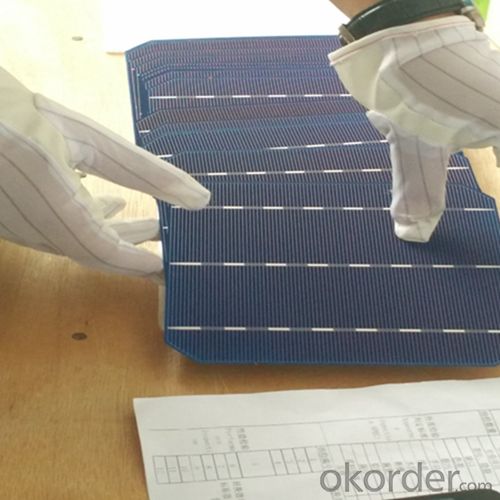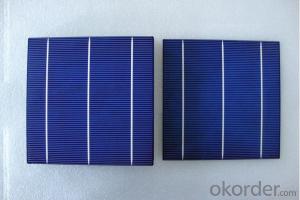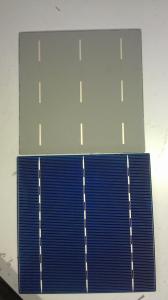Canadian Solar Cells - Poly 156 Solar Cells Class A Made in China
- Loading Port:
- Shanghai
- Payment Terms:
- TT OR LC
- Min Order Qty:
- 6500 watt
- Supply Capability:
- 6000000 watt/month
OKorder Service Pledge
OKorder Financial Service
You Might Also Like
The operation of a photovoltaic (PV) cell requires 3 basic attributes:
The absorption of light, generating either electron-hole pairs or excitons.
The separation of charge carriers of opposite types.
The separate extraction of those carriers to an external circuit.
In contrast, a solar thermal collector supplies heat by absorbing sunlight, for the purpose of either direct heating or indirect electrical power generation from heat. A "photoelectrolytic cell" (photoelectrochemical cell), on the other hand, refers either to a type of photovoltaic cell (like that developed by Edmond Becquerel and modern dye-sensitized solar cells), or to a device that splits water directly into hydrogen and oxygen using only solar illumination.Characteristic of Mono 156X156MM2 Solar Cells
You are gaining energy independence - add battery backup power for even greater energy security
The cost of electricity is only going to rise – insure against that rising cost
Adaptive cells change their absorption/reflection characteristics depending to respond to environmental conditions. An adaptive material responds to the intensity and angle of incident light. At the part of the cell where the light is most intense, the cell surface changes from reflective to adaptive, allowing the light to penetrate the cell. The other parts of the cell remain reflective increasing the retention of the absorbed light within the cell.[67]
In 2014 a system that combined an adaptive surface with a glass substrate that redirect the absorbed to a light absorber on the edges of the sheet. The system also included an array of fixed lenses/mirrors to concentrate light onto the adaptive surface. As the day continues, the concentrated light moves along the surface of the cell. That surface switches from reflective to adaptive when the light is most concentrated and back to reflective after the light moves along
Mechanical data and design
Format | 156mm x 156mm±0.5mm |
Thickness | 210μm±40μm |
Front(-) | 1.5mm bus bar (silver),blue anti-reflection coating (silicon nitride) |
Back (+) | 2.5mm wide soldering pads (sliver) back surface field (aluminium) |
Temperature Coefficient of Cells
Voc. Temp.coef.%/K | -0.35% |
Isc. Temp.coef .%/K | +0.024%/K |
Pm.Temp.coef. %/K | -0.47%/K |
Electrical Characteristic
Effiency(%) | Pmpp(W) | Umpp(V) | Impp(A) | Uoc(V) | Isc(A) | FF(%) |
18.35 | 4.384 | 0.526 | 8.333 | 0.63 | 8.877 | 78.39% |
18.20 | 4.349 | 0.526 | 8.263 | 0.63 | 8.789 | 78.54% |
18.05 | 4.313 | 0.525 | 8.216 | 0.63 | 8.741 | 78.32% |
17.90 | 4.277 | 0.524 | 8.161 | 0.625 | 8.713 | 78.04% |
17.75 | 4.241 | 0.523 | 8.116 | 0.625 | 8.678 | 77.70% |
17.60 | 4.206 | 0.521 | 8.073 | 0.625 | 8.657 | 77.36% |
17.45 | 4.170 | 0.519 | 8.039 | 0.625 | 8.633 | 76.92% |
17.30 | 4.134 | 0.517 | 8.004 | 0.625 | 8.622 | 76.59% |
17.15 | 4.096 | 0.516 | 7.938 | 0.625 | 8.537 | 76.80% |
17.00 | 4.062 | 0.512 | 7.933 | 0.625 | 8.531 | 76.18% |
16.75 | 4.002 | 0.511 | 7.828 | 0.625 | 8.499 | 75.34% |
16.50 | 3.940 | 0.510 | 7.731 | 0.625 | 8.484 | 74.36% |




 FAQ
FAQ
Q: What price for each watt?
A: It depends on the quantity, delivery date and payment terms, generally Large Quantity and Low Price
Q: What is your size for each module? Can you tell me the Parameter of your module?
A: We have different series of panels in different output, both c-Si and a-Si. Please take the specification sheet for your reference.
Q: What is your size for each module? Can you tell me the Parameter of your module?
A: We have different series of panels in different output, both c-Si and a-Si. Please take the specification sheet for your reference.
- Q: What do the solar cell suppliers provide once we purchase the order from the solar cells from them.
- Some of the solar cells suppliers will also provide the construction of the solar cells for your project.
- Q: How do solar cells handle hail or other physical damage?
- Solar cells are designed to be durable and can withstand hail or other physical damage to a certain extent. They are typically made with tempered glass or other strong materials to protect the delicate photovoltaic layers. However, severe hailstorms or significant physical impact can potentially cause damage to the cells, leading to reduced efficiency or complete failure. In such cases, it may be necessary to repair or replace the damaged solar panels.
- Q: What is the impact of dust storms on solar cell efficiency?
- Dust storms can significantly reduce solar cell efficiency by blocking sunlight and accumulating dust particles on the surface of the cells. The dust particles act as a barrier, preventing sunlight from reaching the cells and reducing their ability to generate electricity. This can lead to a decrease in power output and overall efficiency of the solar panels. It is essential to regularly clean and maintain the solar panels to mitigate the negative impact of dust storms and ensure optimal performance.
- Q: How do solar cells perform in areas with limited sunlight?
- Solar cells perform less efficiently in areas with limited sunlight compared to areas with abundant sunlight. This is because solar cells rely on sunlight to generate electricity, and limited sunlight means less energy available for conversion. However, solar cells can still produce electricity in areas with limited sunlight, although at a lower rate, making it important to consider alternative energy sources or optimize the solar cell system's design for maximum efficiency in such areas.
- Q: How do solar cells impact carbon emissions?
- Solar cells have a significant impact on carbon emissions as they generate electricity from the sun's energy, reducing the need for fossil fuel-based power generation. This clean and renewable energy source helps to decrease carbon dioxide emissions, mitigating climate change and promoting sustainable development.
- Q: Can solar cells be used in residential applications?
- Yes, solar cells can be used in residential applications. In fact, they are increasingly being utilized in homes as a renewable and sustainable source of energy. Solar panels can be installed on rooftops or in yards to convert sunlight into electricity, reducing dependency on traditional power grids and lowering energy costs for homeowners.
- Q: How do solar cells perform in cloudy weather?
- Solar cells can still generate electricity in cloudy weather, although their efficiency is reduced compared to sunny conditions. Cloud cover limits the amount of sunlight reaching the solar panels, resulting in a lower energy output. However, modern solar cell technologies are designed to capture diffused sunlight and can still produce a significant amount of electricity even in cloudy weather.
- Q: How do solar cells impact global warming?
- Solar cells have a positive impact on global warming as they generate clean, renewable energy by converting sunlight into electricity, reducing the reliance on fossil fuels. By utilizing solar cells, we can decrease greenhouse gas emissions and mitigate climate change.
- Q: How much land is required to install solar cells?
- The amount of land required to install solar cells depends on various factors such as the capacity of the solar system, efficiency of the solar panels, and the power generation goals. On average, it is estimated that a 1 MW solar power plant requires about 4-5 acres of land. However, with advancements in solar technology, the land requirements are decreasing as solar panels become more efficient and produce more power per square foot.
- Q: Can solar cells be used for powering electric vehicles in motion?
- Yes, solar cells can be used to power electric vehicles in motion. Solar panels can be installed on the roof or body of the vehicle to capture sunlight and convert it into electricity, which can then be used to power the vehicle's electric motor. While the amount of power generated by solar cells may not be sufficient to completely run the vehicle, it can supplement the battery's charge and increase the overall range of the electric vehicle.
Send your message to us
Canadian Solar Cells - Poly 156 Solar Cells Class A Made in China
- Loading Port:
- Shanghai
- Payment Terms:
- TT OR LC
- Min Order Qty:
- 6500 watt
- Supply Capability:
- 6000000 watt/month
OKorder Service Pledge
OKorder Financial Service
Similar products
Hot products
Hot Searches
Related keywords



























